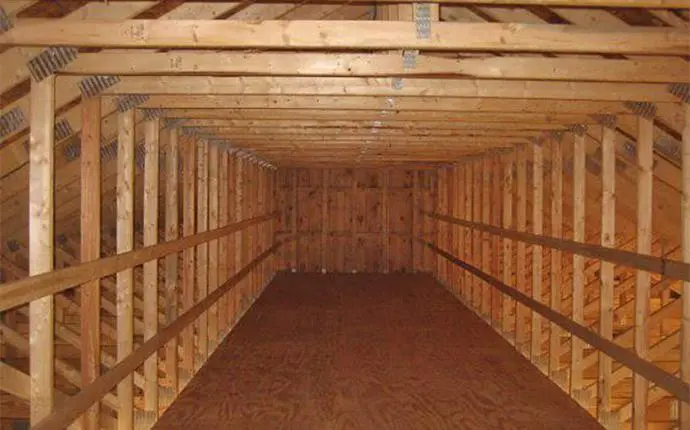As Innovative Inspections, we have performed thousands of home inspections in the Raleigh area. One of the things that pops up consistently during our home inspections are damaged, modified, and or cut engineered trusses. This is a structural issue that can sometimes confuse and scare potential buyers. Here is some more information about what we find and how to handle it during a real estate transaction.
Most trusses used in residential buildings are designed by a licensed structural engineer and made specifically for a home. These are built off-site (made in a factory and shipped to the building lot) and consist of 2” X 4” or 2” X 6” wood, connected by gusset plates (metal connectors), in a web-like pattern. Engineered trusses are designed to distribute weight in a certain manner, allowing weight to be distributed in an exact area according to the engineer’s specifications.
There are basically three different types of trusses that we see during our home inspections:
1. Attic Trusses – Attic trusses are found at the roof level. Here, at the top edge of the truss, the roof sheathing is attached and shingles are applied to create a watertight covering for the house. Different designs allow for different uses of the space created between the living area and the roof. Some designs do not allow any storage and would be hard to navigate around in the open area. Others are designed to allow for storage, platforms for water heaters/HVAC units, and some can have an opening large enough to build a living area within.
2. Floor Trusses – As their name implies, floor trusses are found holding up the floor in the structure. They can be between the crawlspace and the first floor or between any of the living floors. Floor sheathing is attached to the top of the truss and then the final floor is installed. Like the attic truss, the floor truss consists of 2” X 4”’s attached with gusset plates in a web-like pattern.
3. Engineered Joist (I-joist) – Although not specifically called a truss, an engineered joist is created the same way. These are designed by structural engineers and manufactured off-site and shipped to the building site. One of the big differences from a truss is the engineered joist can be cut to length (not randomly cut) to fit the job and may not be specifically designed to fit a particular area of the house. These joists consist of a bottom and top flange with plywood webbing in between. The I-joist can be found used as floor support between the crawlspace and the first floor and also between other floor levels.
Many of our new houses in the Raleigh area are constructed using one or a combination of the above-engineered products. The problems that we find that involve these engineered products are not how they are installed but more often how they are damaged and/or modified during the building process. Remember that all of these products are made off-site. Many times these components can be damaged during shipping, loading, off-loading, ran over while sitting on the building site, damaged when lifted in place, etc. So this is where the first of the problems can occur.
When framing is complete on a new construction home, other trades come in to perform their work. Plumbers have to install drains and water supply lines, electricians have to run electrical lines and install junction boxes, mechanical contractors have to install air conditioning ductwork throughout the house, and whole house vacuum systems are installed. During the installation of these systems, many times a truss will be cut through to make way for duct/drain/etc. and not repaired properly.
The third way we see problems with engineered structural products is when a homeowner takes matters in their own hands. We have seen countless times during our home inspections that attic trusses have been cut/removed because they were in the way. The webs will be cut to make way for more/easier storage or the most often case the bottom chord is cut for an attic truss to install attic pull downstairs.
Anytime that an engineered truss and/or joist is modified and/or repaired it must be done so following the truss manufacturers’ instruction or under the direction of a licensed structural engineer.
The above statement always applies during our home inspections. We are not licensed structural engineers and we cannot determine if damage/repairs/modifications are done correctly. (The only exception being if we have the engineer’s report in hand and can follow their step by step repair instruction, we may be able to determine if that engineer’s direction has been followed.)
When we find any damage/repairs/modifications to an engineered product we must report it. This can be as small as water pipe going through a chord, plumbing drains installed through an I-joist, installation of attic pull-down stairs through the bottom chord of attic truss, to a homeowner removing all the vertical webbing on the trusses over an entire garage (yes this happened). When modifications are found some action needs to occur and here are some suggestions.
If the problem is found in a new home the builder is either aware of the problem or has kno idea that the truss has been damaged. If modifications and/or repairs have occurred to an engineered component and the builder knows about it, this is usually brought to the attention of the local municipality permit department and the area is documented as being repaired/modified and some record should be on file. Request this from your builder. If the repair/modification is not known it is now the responsibility of the builder to go through the proper process and some paperwork should be generated. This paperwork should be kept as long as you own the house because it is likely to come back up when you sell the home.
If the issue is found on an existing home there are several things that can be done. One, you can hire your own licensed structural engineer ($350-500) to inspect to see if repairs are needed, if so direction is given on how to properly repair the areas. Two, ask the seller to have the area repaired according to the direction of the licensed structural engineer. This puts all the expenses on the seller (which some will not do) and areas should be repaired according to the structural engineer’s report. Three, ignore it, and hope for the best. In some minor cases, this may seem the cheapest way to go and the damage may have no impact on the structural stability of the home. However, when the house is sold again this could very easily be found by the next home inspector and the repair cost could be surprising. In all three of these scenarios, any paperwork should be kept for as long as you own the home and handed off to the new homeowner to keep.
In almost all cases, repairs can be made to the truss. Very rarely would the entire truss have to be replaced. Also, repairs are typically not very expensive, and many trusses are cheaper to fix than the actual report on how to fix them. However, in some extreme cases, the repair can be quiet intensive and can cost over $1,000.
In my opinion, I would always want to learn more about the truss and what the cost of repairs will be. It can seem that a small notch in a truss is no big deal but this could cause structural failure if cut in the wrong area. The more you know the better.





